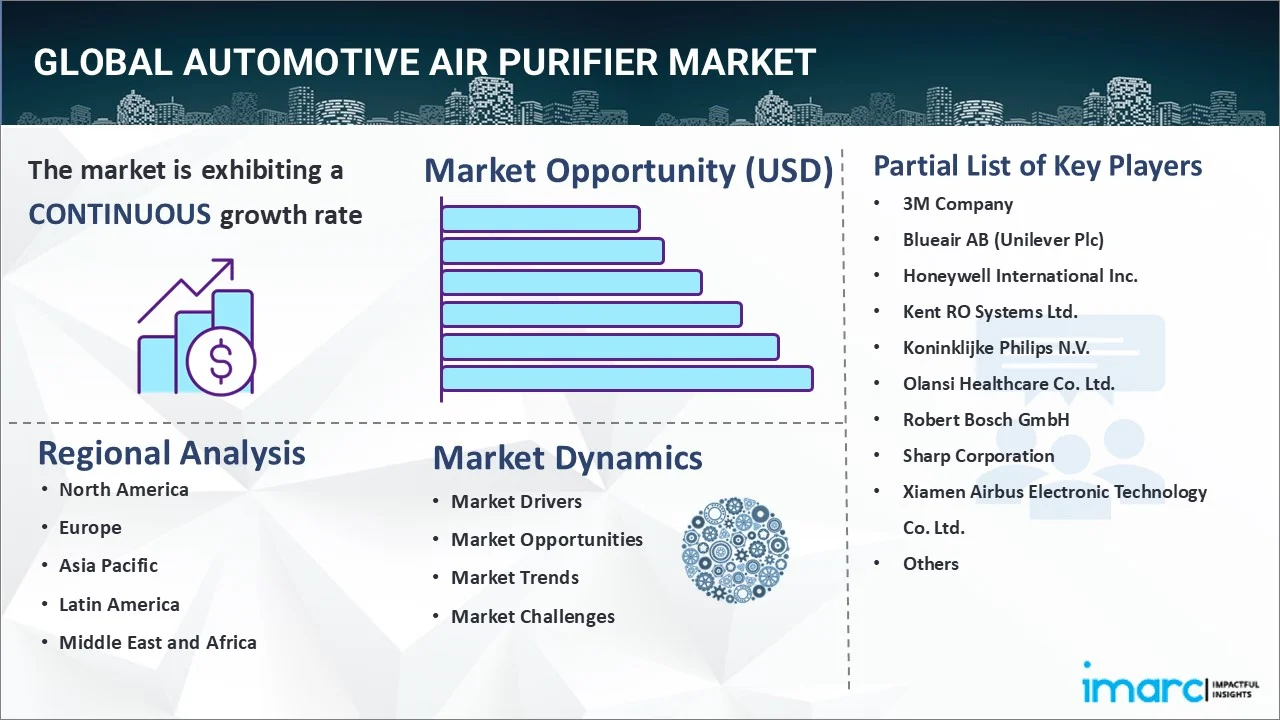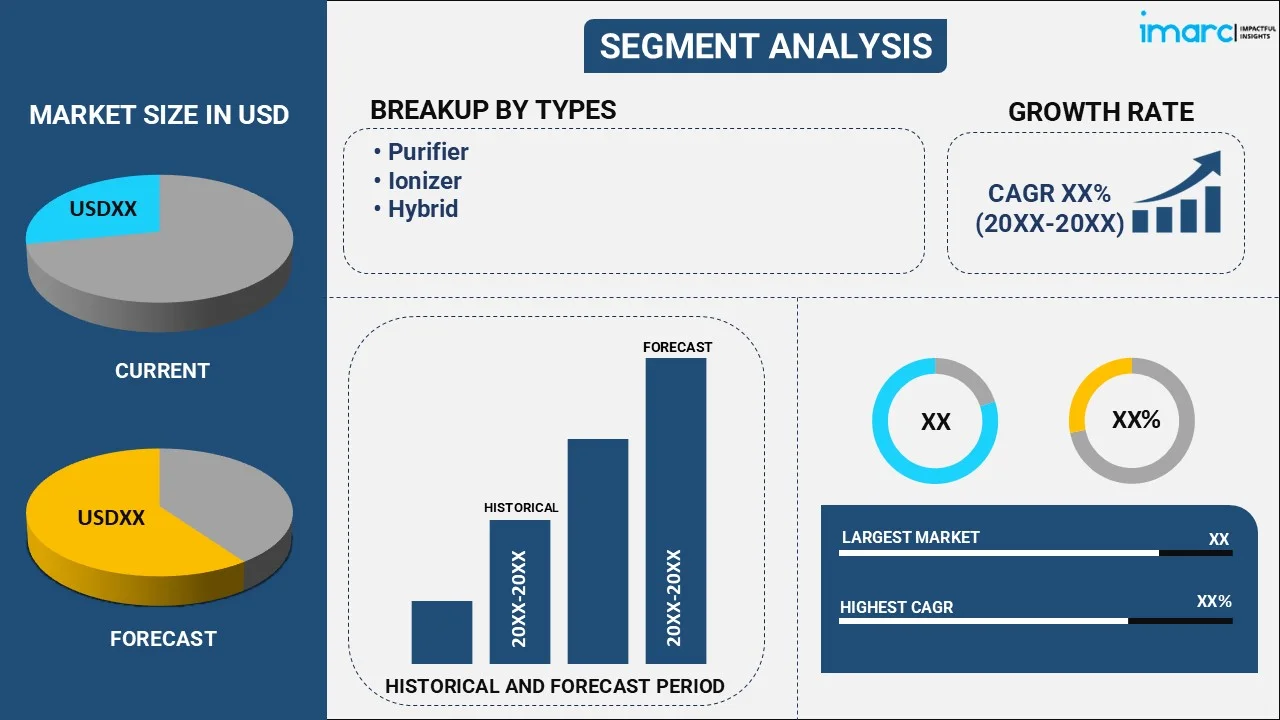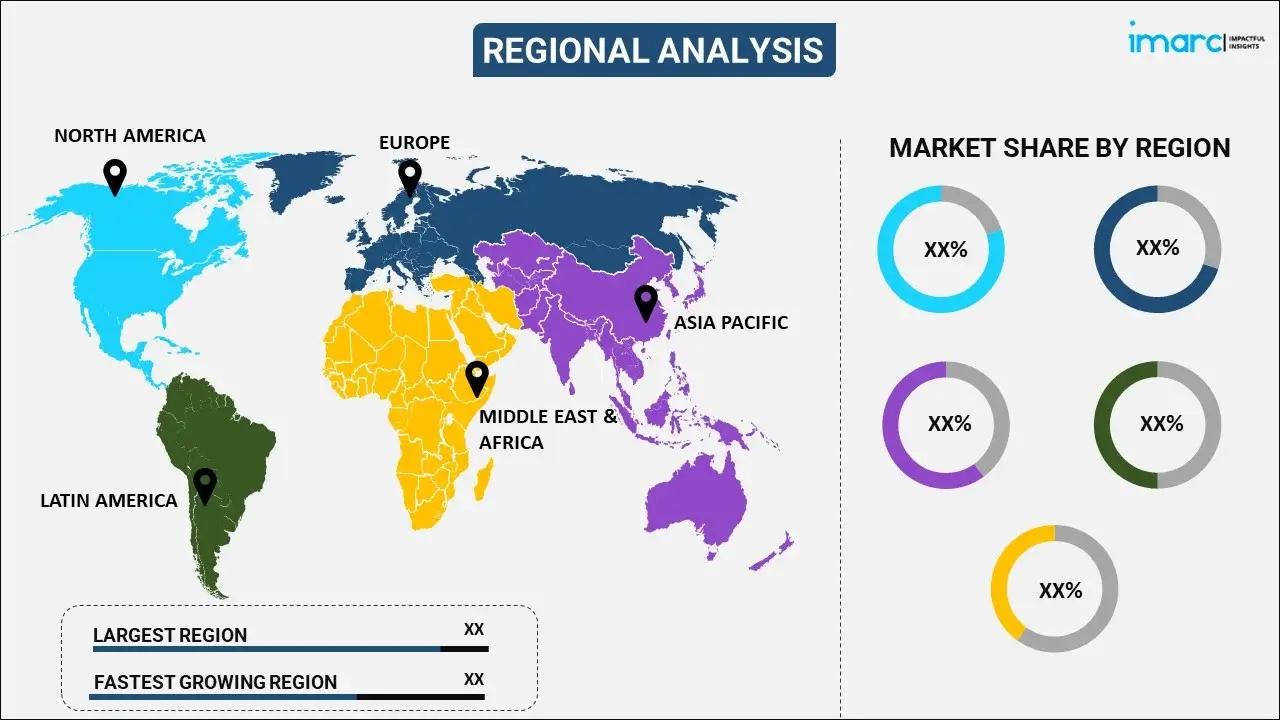
Automotive Air Purifier Market Report by Type (Purifier, Ionizer, Hybrid), Technology (HEPA, Activated Carbon, Ionic Filter, Photo Catalytic), Vehicle Type (Passenger Cars, Commercial Vehicles), Sales Channel (OEM, Aftermarket), and Region 2025-2033
Market Overview:
The global automotive air purifier market size reached USD 1,637.0 Million in 2024. Looking forward, IMARC Group expects the market to reach USD 3,942.7 Million by 2033, exhibiting a growth rate (CAGR) of 9.75% during 2025-2033. The rising awareness about health and air quality, elevating urban air pollution due to rapid industrialization, and advancements in air purification technologies, such as HEPA filters, activated carbon, and ionizers, are some of the major factors propelling the market.
|
Report Attribute
|
Key Statistics
|
|---|---|
|
Base Year
|
2024 |
|
Forecast Years
|
2025-2033
|
|
Historical Years
|
2019-2024
|
| Market Size in 2024 | USD 1,637.0 Million |
| Market Forecast in 2033 | USD 3,942.7 Million |
| Market Growth Rate (2025-2033) | 9.75% |
Automotive air purifiers are compact devices designed specifically for vehicles to maintain optimal air quality within the car cabin. Their primary function is to cleanse the interior air by eliminating various pollutants such as dust, smoke, allergens, bacteria, and harmful volatile organic compounds (VOCs) that can adversely affect passengers' health. Some air purifiers utilize High Efficiency Particulate Air (HEPA) filters, which are highly effective in trapping airborne particles, thereby reducing the risk of respiratory issues. They may also incorporate advanced technologies such as activated carbon filters or ionizers to neutralize unpleasant odors and create a more comfortable driving environment. As a result, automotive air purifiers are widely used to promote a healthier in-car atmosphere and enhance the overall driving experience by providing cleaner and fresher air.

To get more information on this market, Request Sample
The increasing pollution levels across the globe, coupled with the growing health awareness among the masses, are contributing to the surging popularity of automotive air purifiers as an essential addition to vehicles for drivers. Moreover, a significant rise in car ownership globally, especially in emerging economies, will stimulate the growth of the market. Besides this, numerous countries worldwide are implementing stricter regulations to maintain air quality standards. Such policies are encouraging and mandating the use of air purifiers in vehicles, particularly in commercial ones, further propelling market growth. Furthermore, due to the recent coronavirus (COVID-19) pandemic, the heightening awareness about airborne diseases and the escalating need for hygiene, which extends to vehicles, is driving the market toward growth. Apart from this, continual advancements in technology, rapid urbanization, and inflating automobile sales are some of the other factors contributing to the market growth.
Automotive Air Purifier Market Trends/Drivers:
Rise in health awareness among individuals
The increasing awareness about the link between health and air quality is a significant factor driving the market. Research has shown that constant exposure to airborne pollutants can lead to numerous health problems, including respiratory diseases, allergies, and even cardiovascular issues. As a result, consumers are actively seeking solutions to improve air quality in their personal spaces, including cars. This heightened consciousness about health, coupled with a better understanding of the benefits of air purifiers, is encouraging more vehicle owners to invest in automotive air purifiers. The trend is particularly noticeable among urban commuters who spend substantial time in their vehicles and are exposed to various pollutants.
Surge in the levels of urban air pollution
Rapid urbanization and industrialization are contributing to the worsening air quality worldwide, particularly in urban and semi-urban areas. Emissions from industries, vehicular exhaust, and other human activities fill the air with harmful pollutants, such as particulate matter, nitrogen oxides, carbon monoxide, and volatile organic compounds. In response, individuals are inclining toward automotive air purifiers as a solution to mitigate these adverse effects while traveling. This is especially relevant in countries with burgeoning cities and elevating pollution levels, where the need for such devices is becoming critical to ensure a healthier and safer in-car environment, which in turn is fueling the growth of the market.
Ongoing advancements in technology
Over the years, the efficiency and effectiveness of air purifiers have significantly improved, owing to the development of novel and enhanced technologies such as HEPA filters, activated carbon, and ionizers. These technologies can effectively remove a broader range of pollutants, including ultrafine particles and bad odors. This development not only provides a more hygienic in-car atmosphere but also improves the overall driving experience. Furthermore, the leading manufacturers are integrating smart features into these devices, such as real-time air quality monitoring and automatic mode adjustments, adding to their appeal. Such advancements have widened consumer choices and are crucial in promoting the product adoption, thereby catalyzing the market growth.
Automotive Air Purifier Industry Segmentation:
IMARC Group provides an analysis of the key trends in each segment of the global automotive air purifier market report, along with forecasts at the global, regional, and country levels from 2025-2033. Our report has categorized the market based on the type, technology, vehicle type, and sales channel.
Breakup by Type:

- Purifier
- Ionizer
- Hybrid
Hybrid represents the most popular segment
The report has provided a detailed breakup and analysis of the market based on the type. This includes purifier, ionizer, and hybrid. According to the report, hybrid represented the largest segment.
Hybrid automotive air purifiers combine multiple purification technologies such as HEPA filters, activated carbon, and ionizers. Their enhanced efficacy in eliminating a broader range of pollutants compared to single-technology purifiers represents the primary factor driving the segment growth. Hybrid purifiers offer a comprehensive solution as they are capable of filtering out particulate matter and harmful gases, neutralizing bad odors, and even eliminating bacteria or viruses, providing superior air quality. Moreover, with increasing consumer awareness, there is a growing demand for high-performance devices that deliver comprehensive air purification. Additionally, advancements in technology have allowed manufacturers to integrate multiple purification methods without significantly increasing the size or cost of the device. This makes hybrid air purifiers a cost-effective option for consumers seeking comprehensive air purification solutions. Their superior performance, versatility, and cost-effectiveness have made hybrid automotive air purifiers the preferred choice for a wide range of consumers, propelling the segment growth.
Breakup by Technology:
- HEPA
- Activated Carbon
- Ionic Filter
- Photo Catalytic
HEPA accounts for the majority of the market share
The report has provided a detailed breakup and analysis of the market based on technology. This includes HEPA, activated carbon, ionic filter, and photo catalytic. According to the report, HEPA represented the largest segment.
High Efficiency Particulate Air (HEPA) filters can capture at least 99.97% of particles that are 0.3 microns in diameter, making them highly effective at removing airborne pollutants such as dust, pollen, mold spores, and other allergens. The main factors that are driving the growth of this segment include the high efficiency and wide range of applications of HEPA. These filters are particularly valuable as they can significantly improve the air quality inside vehicles, which are often exposed to high levels of pollution, especially in urban areas. The rising public awareness about the health risks associated with poor air quality is supporting the expansion of this segment. Furthermore, the increasing affordability and accessibility of HEPA filters due to technological advancements, coupled with their proven effectiveness, is fueling the segment growth.
Breakup by Vehicle Type:
- Passenger Cars
- Commercial Vehicles
Passenger cars dominate the market
The report has provided a detailed breakup and analysis of the market based on the vehicle type. This includes passenger cars and commercial vehicles. According to the report, passenger cars represented the largest segment.
Passenger cars are often used for daily commuting and long-distance travel, leading to a significant amount of time spent inside these vehicles. Due to the confined space and high pollution levels, especially in urban areas, maintaining optimal air quality inside passenger cars becomes essential. This necessity strengthens the demand for automotive air purifiers in passenger cars. Also, the high volume of passenger cars, coupled with the surging awareness of air quality and its impact on health, is propelling the expansion of this segment. Besides this, the rise of shared mobility services, such as Uber and Lyft, has led to an increased focus on enhancing the customer experience, which includes ensuring clean and comfortable in-vehicle environments. Thus, many operators in this sector are also adopting automotive air purifiers, further bolstering the passenger cars segment growth.
Breakup by Sales Channel:
- OEM
- Aftermarket
Aftermarket accounts for the majority of the market share
The report has provided a detailed breakup and analysis of the market based on the sales channel. This includes OEM and aftermarket. According to the report, aftermarket represented the largest segment.
Aftermarket air purifiers offer the advantage of wide compatibility as they can be easily installed in a broad range of vehicle models, irrespective of make, model, or year. This flexibility makes aftermarket purifiers an attractive option for many car owners. Moreover, the availability of a wider variety of choices in the aftermarket allows consumers to select from various brands, technologies, and price points, to find a product that fits their specific needs and budget. Besides this, the cost effectiveness and ease of upgrade and replacement offered by aftermarket air purifiers are augmenting the segment growth.
Breakup by Region:

- North America
- United States
- Canada
- Europe
- Germany
- France
- United Kingdom
- Italy
- Spain
- Others
- Asia Pacific
- China
- Japan
- India
- South Korea
- Australia
- Indonesia
- Others
- Latin America
- Brazil
- Mexico
- Others
- Middle East and Africa
Europe exhibits a clear dominance, accounting for the largest automotive air purifier market share
The report has also provided a comprehensive analysis of all the major regional markets, which include North America (the United States and Canada); Europe (Germany, France, the United Kingdom, Italy, Spain, and others); Asia Pacific (China, Japan, India, South Korea, Australia, Indonesia, and others); Latin America (Brazil, Mexico, and others); and the Middle East and Africa. According to the report, Europe accounted for the largest market share.
Europe held the largest market share since the region exhibits high awareness and concern about health and wellness. There is a growing recognition of the impact of air quality on overall health, leading to a higher demand for products that can ensure cleaner and healthier environments, including automotive air purifiers. Moreover, the region has one of the highest rates of vehicle ownership per capita worldwide. This vast volume of vehicles creates a significant demand for automotive air purifiers.
Moreover, Europe has stringent regulations related to air quality and emissions. These regulatory measures often encourage or even mandate the use of air purification technologies in vehicles, further driving the market growth. Another contributing aspect is the presence of a significant number of global automobile manufacturers and aftermarket product suppliers that actively promote and market automotive air purifiers, further boosting consumer awareness and adoption. Also, the inflating disposable incomes of European consumers and escalating demand for products like high-end air purifiers are stimulating market growth in this region.
Competitive Landscape:
The market is experiencing steady growth as the leading companies are focusing on product development and innovation to deliver more efficient and effective air purifiers. Various key players are adopting several strategies to maintain their market position and meet the growing demand. They are also partnering with automobile manufacturers, technology providers, and even shared mobility services to expand their geographical reach. The market is witnessing a surge in investments in marketing and promotional activities by vendors to improve brand awareness and educate consumers about the importance and benefits of automotive air purifiers. The market is projected to witness new entrants, surge in research-related efforts, and increased focus on expanding distribution networks, both online and offline, to drive healthy competition within the domain.
The report has provided a comprehensive analysis of the competitive landscape in the market. Detailed profiles of all major companies have also been provided. Some of the key players in the market include:
- 3M Company
- Blueair AB (Unilever Plc)
- Honeywell International Inc.
- Kent RO Systems Ltd.
- Koninklijke Philips N.V.
- Olansi Healthcare Co. Ltd.
- Robert Bosch GmbH
- Sharp Corporation
- Xiamen Airbus Electronic Technology Co. Ltd.
- Xiaomi Corporation
Automotive Air Purifier Market Report Scope:
| Report Features | Details |
|---|---|
| Base Year of the Analysis | 2024 |
| Historical Period | 2019-2024 |
| Forecast Period | 2025-2033 |
| Units | Million USD |
| Scope of the Report | Exploration of Historical and Forecast Trends, Industry Catalysts and Challenges, Segment-Wise Historical and Predictive Market Assessment:
|
| Types Covered | Purifier, Ionizer, Hybrid |
| Technologies Covered | HEPA, Activated Carbon, Ionic Filter, Photo Catalytic |
| Vehicle Types Covered | Passenger Cars, Commercial Vehicles |
| Sales Channels Covered | OEM, Aftermarket |
| Regions Covered | Asia Pacific, Europe, North America, Latin America, Middle East and Africa |
| Countries Covered | United States, Canada, Germany, France, United Kingdom, Italy, Spain, China, Japan, India, South Korea, Australia, Indonesia, Brazil, Mexico |
| Companies Covered | 3M Company, Blueair AB (Unilever Plc), Honeywell International Inc., Kent RO Systems Ltd., Koninklijke Philips N.V., Olansi Healthcare Co. Ltd., Robert Bosch GmbH, Sharp Corporation, Xiamen Airbus Electronic Technology Co. Ltd., Xiaomi Corporation, etc. |
| Customization Scope | 10% Free Customization |
| Post-Sale Analyst Support | 10-12 Weeks |
| Delivery Format | PDF and Excel through Email (We can also provide the editable version of the report in PPT/Word format on special request) |
Key Questions Answered in This Report:
- How has the global automotive air purifier market performed so far, and how will it perform in the coming years?
- What are the drivers, restraints, and opportunities in the global automotive air purifier market?
- What is the impact of each driver, restraint, and opportunity on the global automotive air purifier market?
- What are the key regional markets?
- Which countries represent the most attractive automotive air purifier market?
- What is the breakup of the market based on the type?
- Which is the most attractive type in the automotive air purifier market?
- What is the breakup of the market based on the technology?
- Which is the most attractive technology in the automotive air purifier market?
- What is the breakup of the market based on the vehicle type?
- Which is the most attractive vehicle type in the automotive air purifier market?
- What is the breakup of the market based on the sales channel?
- Which is the most attractive sales channel in the automotive air purifier market?
- What is the competitive structure of the global automotive air purifier market?
- Who are the key players/companies in the global automotive air purifier market?
Key Benefits for Stakeholders:
- IMARC’s report offers a comprehensive quantitative analysis of various market segments, historical and current market trends, market forecasts, and dynamics of the automotive air purifier market from 2019-2033.
- The research study provides the latest information on the market drivers, challenges, and opportunities in the global automotive air purifier market.
- The study maps the leading, as well as the fastest-growing, regional markets. It further enables stakeholders to identify the key country-level markets within each region.
- Porter's five forces analysis assist stakeholders in assessing the impact of new entrants, competitive rivalry, supplier power, buyer power, and the threat of substitution. It helps stakeholders to analyze the level of competition within the automotive air purifier industry and its attractiveness.
- Competitive landscape allows stakeholders to understand their competitive environment and provides an insight into the current positions of key players in the market.
Need more help?
- Speak to our experienced analysts for insights on the current market scenarios.
- Include additional segments and countries to customize the report as per your requirement.
- Gain an unparalleled competitive advantage in your domain by understanding how to utilize the report and positively impacting your operations and revenue.
- For further assistance, please connect with our analysts.
 Request Customization
Request Customization
 Speak to an Analyst
Speak to an Analyst
 Request Brochure
Request Brochure
 Inquire Before Buying
Inquire Before Buying




.webp)




.webp)












